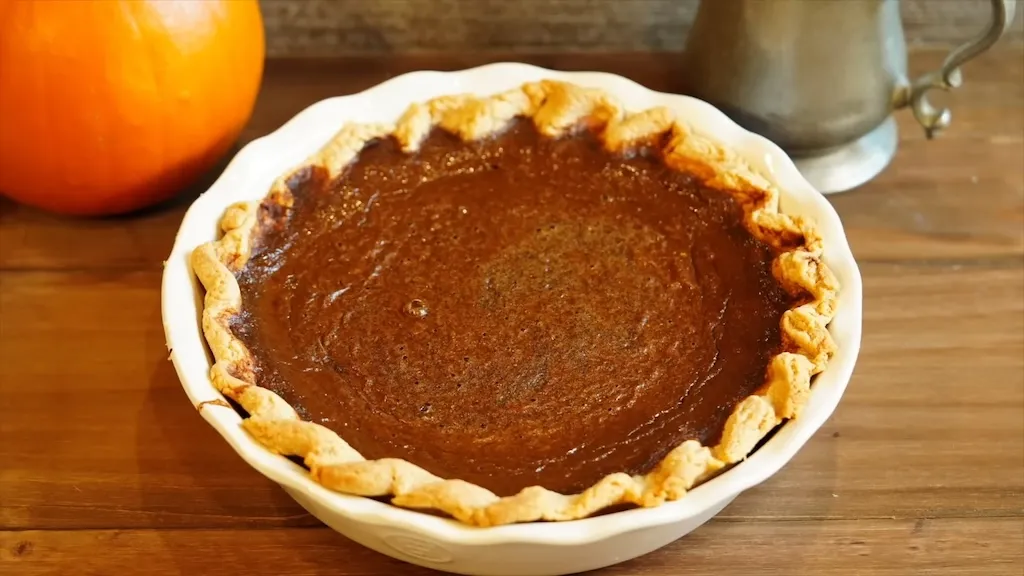The 1796 Pumpkin Pie Recipe: A Culinary Journey Through History
Exploring the Historical Context of the 1796 Pumpkin Pie Recipe
The 1796 Pumpkin Pie Recipe holds a special place in the culinary history of America. Originating from Amelia Simmons’ groundbreaking cookbook, “American Cookery,” this recipe marks the evolution of pumpkin pie from a simple, rustic dish to a beloved staple of American cuisine. Consequently, the significance of this recipe lies not just in its delicious taste but also in its representation of early American cooking techniques and ingredients.
Ingredients of the Original 1796 Pumpkin Pie Recipe
- Traditional Ingredients: The recipe calls for simple, wholesome ingredients like fresh pumpkin, molasses, and spices.
- Fresh Pumpkin: 1 pint (about 2 cups) of pumpkin puree. For an authentic touch, use fresh pumpkin. Cut it in half, remove the seeds, bake it until soft, and then mash it.
- Milk: 1 quart (4 cups). This adds creaminess to the pie filling.
- Eggs: 4 large eggs, well beaten. Eggs help to bind the filling and give it a smooth texture.
- Molasses: ½ cup. This sweetener was commonly used in the 18th century and gives the pie a rich, caramel-like flavor.
- Ginger: 1 teaspoon, ground. Adds a warm, spicy note.
- Allspice: 1 teaspoon. This spice was popular in historical recipes and offers a blend of cinnamon, nutmeg, and cloves flavors.
For the Pie Crust:
- Flour: For a standard pie crust, use about 2 ½ cups of all-purpose flour.
- Butter or Lard: About 1 cup (2 sticks) of butter or an equivalent amount of lard. This gives the crust its flaky texture.
- Salt: A pinch, to enhance the flavor.
- Cold Water: Approximately 6 tablespoons, enough to bring the dough together.
- Understanding Historical Ingredients: Some ingredients from the 18th century may seem unfamiliar to modern cooks.
- Furthermore, for an in-depth look at the ingredients and their historical context, visit Savoring the Past.
Preparing the Pumpkin: From Scratch vs. Canned Options
- Fresh Pumpkin Preparation: Baking and mashing fresh pumpkin for an authentic flavor.
- Canned Pumpkin: Modern convenience offering a quicker alternative without compromising too much on taste.
- Additionally, learn more about preparing pumpkin for the pie with insights from The Regency Cook.
The Art of Making 1796 Pumpkin Pie
Directions:
Preparing the Pumpkin:
- Bake the Pumpkin: Preheat your oven to 350°F (175°C). Cut the pumpkin in half and remove the seeds. Place the halves face down on a baking sheet and bake for about 1 hour or until the flesh is soft. Let it cool, then scoop out the flesh and mash it to make 1 pint of puree.
Making the Pie Crust:
- Mix the Dough: In a large bowl, combine the flour and salt. Cut in the butter or lard until the mixture resembles coarse crumbs. Gradually add cold water, stirring until the dough comes together.
- Chill the Dough: Wrap the dough in plastic and chill in the refrigerator for at least 30 minutes.
- Roll Out the Dough: On a floured surface, roll out the dough to fit your pie dish.
Preparing the Filling:
- Combine Ingredients: In a large mixing bowl, combine the pumpkin puree, milk, beaten eggs, molasses, ginger, and allspice. Mix well until smooth.
Assembling and Baking the Pie:
- Preheat Oven: Preheat your oven to 325°F (163°C).
- Fill the Pie Crust: Pour the pumpkin filling into the unbaked pie crust.
- Bake the Pie: Bake in the preheated oven for about 75 minutes, or until the filling is set and the crust is golden brown.
- Cool Before Serving: Let the pie cool completely before slicing. This allows the filling to set properly.
- Mixing the Ingredients: Combining pumpkin with molasses, eggs, and spices.
- Creating the Pie Crust: Using a simple pastry dough for the crust.
- Importantly, this part of the process is crucial as it sets the foundation for the pie’s flavor and texture.
Understanding the Baking Process
- 18th Century Baking Techniques: Insights into how baking methods have changed since 1796.
- Modern Baking Adaptations: Adjusting the recipe for contemporary ovens.
- Therefore, the baking process is key to achieving the perfect consistency and flavor of the pie.
Serving and Presentation
- Historical Presentation: Serving the pie as it would have been in the 18th century.
- Modern Presentation Ideas: Adapting the presentation for today’s dining standards.
- Moreover, presentation plays a significant role in how the pie is perceived and enjoyed.
Recipe Variations and Adaptations
- Modern Palate Adaptations: Tweaking the recipe to suit contemporary taste preferences.
- Dietary Considerations: Making gluten-free and vegan versions of the historic recipe.
- These variations ensure that the recipe remains relevant and accessible to a wide audience.
Pairing and Accompaniments
- Traditional Pairings: Suggestions for dishes and drinks that complement the pie.
- Modern Pairings: Contemporary sides and beverages that go well with pumpkin pie.
- Pairing the pie with the right accompaniments can enhance the overall dining experience.
FAQs
- Common Questions: Addressing queries about ingredient substitutions and baking tips.
- Historical Recipe Tips: Guidance for those trying historical recipes for the first time.
- This section aims to address any uncertainties or questions that readers might have about the recipe.
Conclusion
In conclusion, the 1796 Pumpkin Pie Recipe is more than just a dessert; it’s a piece of culinary history. Whether you’re a seasoned baker or new to historical recipes, making this pumpkin pie is a delightful way to connect with the past. Hence, why not bring a taste of history to your table with this time-honored recipe?
For those interested in exploring more historical recipes and their modern adaptations, Bannockburn House offers a fascinating collection of 17th-century pumpkin pie recipes and their contemporary versions.
Additionally, if you’re looking for other creative and homemade recipes that blend history with modern culinary techniques, be sure to check out our Chicken Cobbler recipe, which pairs wonderfully with traditional dishes like pumpkin pie.

